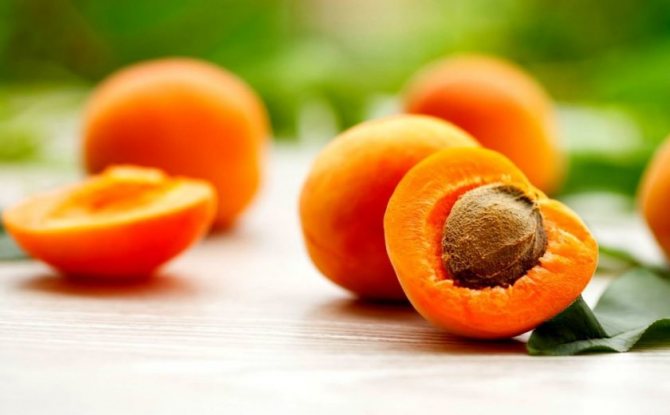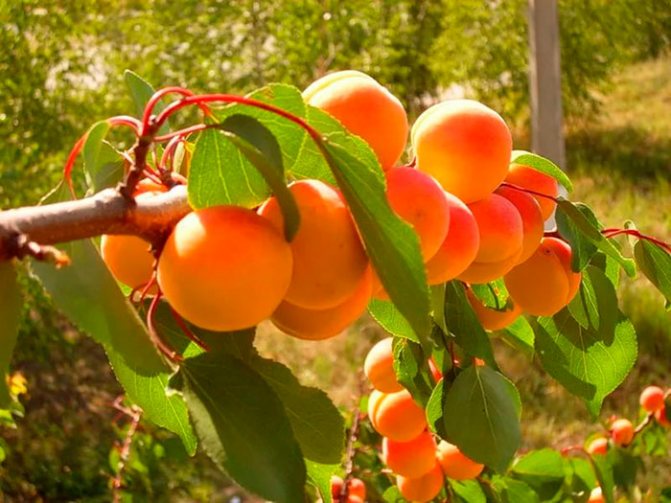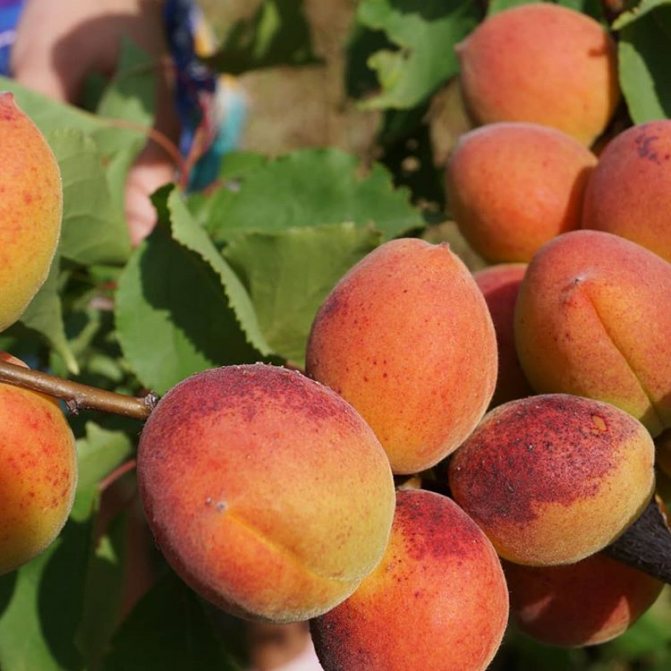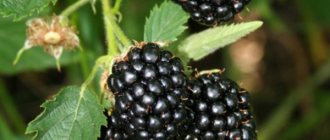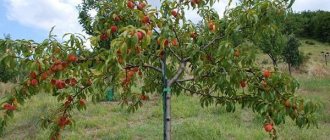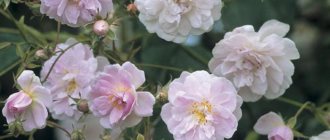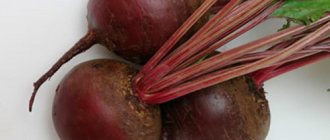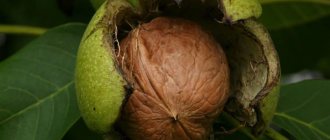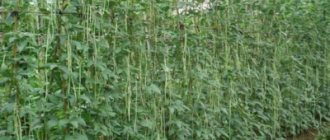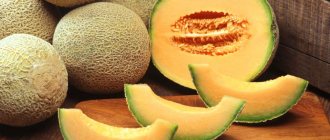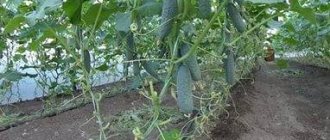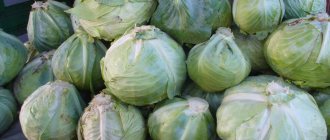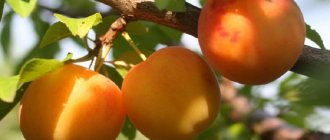Hello my dear readers! Apricot is such a delicious fruit that every summer resident wants to have it on his site. But what should residents of far from southern regions do? In fact, thanks to selection, frost-resistant varieties have been bred that take root well even in cold winters.
Therefore, summer residents simply have to get to know what the best varieties of apricots are for the Moscow region and get down to business. And there are really a lot of them, and each species has its own ripening period.
Early maturation
If you want to get early fruits, then you should pay attention to the varieties that ripen the fastest. These include:
Laureate
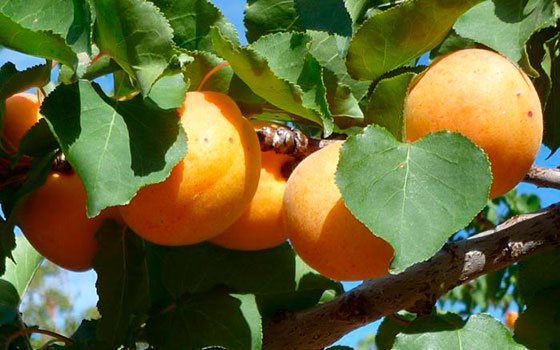
This is the earliest tree with a fairly high yield. It grows up to 3 meters in height and bears the first fruits already for 3-4 years. Apricots will be large in size with soft and juicy flesh. It belongs to winter-hardy varieties, therefore it is suitable not only for the Moscow region, but also for more northern regions.
But in order for the tree to bloom, it is necessary to carry out constant drainage, in addition, it prefers fertile soils, starting with medium loamy and ending with sandy loam soils.
It is important that there is no stagnant water on the site, otherwise the plant will rot. Also, for successful growth, the landing site is chosen in such a way that there are no drafts on it. Annual pruning contributes to good yields in July and August. Despite such a relative fastidiousness in care, the Laureate is highly resistant to various diseases of the fungal form and pests.
Early
The fruit is yellow in color with a pink tint, the flesh is yellow and sweet. Fruiting begins at 3-4 years in June, the fruits are large. A fairly resistant species to diseases and pests.
Alyosha
An adult tree grows up to 4 m in height. The peel of the fruit is yellow with dots, while having a shiny surface. Elliptical shape. One fruit with orange pulp weighs on average 20 g. Unlike its counterparts, the Alyosha variety has a sweet and sour taste.
Columnar
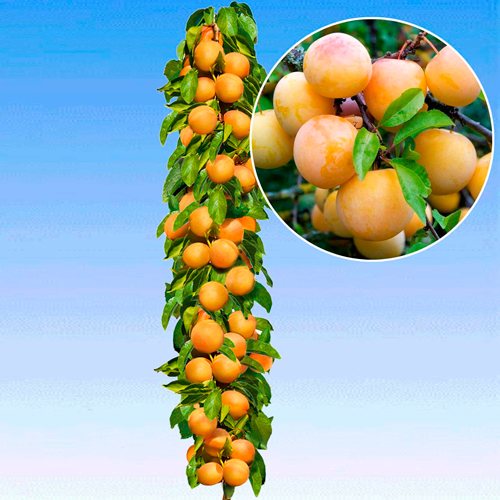

Another name for the variety is Prince. This name (columnar) tree received due to its relatively "compact" growth - 2 - 2.5 m in height and short branches. Among summer residents it enjoys special respect, since the first fruits can already be harvested from young seedlings, and not wait until the tree is fully grown. This occurs in the 2nd year of planting.
The weight of one fruit varies between 30-40 g. Among other things, this variety does not require pollination, therefore it belongs to the category of self-fertile plants. The first fruits appear in August, but under good conditions, sweet pulp can be enjoyed at the end of July. But only they do not have the property of being stored for a long time, so they need to be consumed or processed immediately.
All these varieties begin to bear fruit already from the middle of summer, while they are absolutely not picky about care. Therefore, they can even be combined with each other so that juicy and sweet apricots stand on the table until the very end of summer.
Diseases and pests
In the reviews and description of the Snegirek apricot variety, the tree's weak immunity to diseases such as moniliosis, cytosporosis, fusarium, rot, and curl leaves are noted. To prevent pathologies from affecting the bark, foliage and fruits, it is necessary to carry out proactive treatments with copper-containing preparations.Particular attention should be paid to treatments after rainy weather.
How to prevent the appearance of diseases on the tree? Fungal pathology moniliosis appears on the tree after a sharp drop in temperature. Mushrooms multiply rapidly, turning flowers, leaves, twigs into something like a burn. To prevent this from happening, it is necessary to treat it with Bordeaux mixture or "Horus" in early spring after flowering. If, nevertheless, the fungus has infected the tree, you need to remove the infected branches and fruits. It is imperative to whitewash the tree with a mixture of copper sulfate.
If it is noticed that the tops of the shoots have begun to turn brown, the leaves wither, and spots have appeared on the bark of the tree, these are signs of cytosporosis. First, you need to anoint all the wounds with garden varnish, and the next step will be treatment with an antifungal drug "Hom".
To prevent ticks and sawflies from parasitizing the tree, weeds must be removed and burned. Spraying with insecticides gives a good result.
If the tree is not deprived of regular watering, fertilizing and protection from adverse environmental conditions and pests, it will definitely appreciate taking care of itself and bring an excellent harvest.
Gardeners are increasingly occupying planting areas with Snegirek apricot. The variety is frost-resistant. The owners of small summer cottages are especially fond of it: the tree rarely grows more than 2 m.
Mid-season varieties
Everyone is accustomed to feasting on such fruits in the second half of summer. If you do not want to break this tradition, then you should familiarize yourself with the description of the following varieties, and then decide whether to grow them on your site.
Red-cheeked
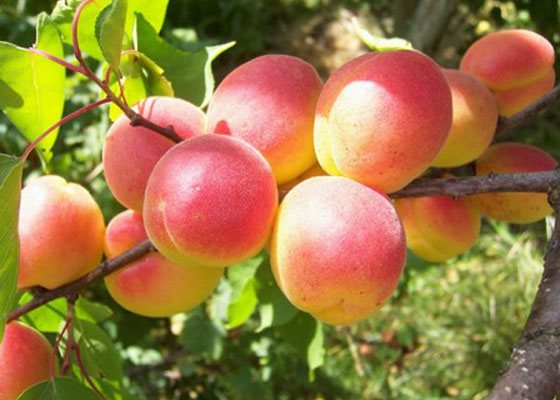

The first fruits appear 3-4 years after planting. Each apricot reaches a weight of about 50 g, with a golden, thin skin. Thanks to this, they make excellent jam and jam. Fresh fruits can be stored for 5-7 days. The red-cheeked variety is not only winter-hardy, but also tolerant of droughts. But if the trees are not watered, the harvest will be smaller. It is also recommended to cover the apricot for the winter, even if the winter is mild.
Dessert
As the name implies, such apricots are distinguished by their taste. Like the previous type, the dessert one belongs to the category of tall trees. The average height of an adult plant is 4-5 m. Fruiting occurs by the middle of the first summer month. It tolerates winter frosts well, so it is easy to find in the northern regions.
Khabarovsk
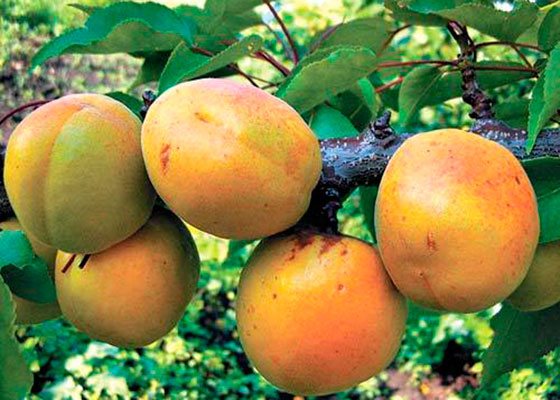

The progenitor is the Red-cheeked variety. The average fruit weight is 40-45 g. A distinctive feature is the presence of a deep seam on the fruit. There is a fairly dense pulp that allows good preservation. This variety begins to bear fruit relatively late - at 4-5 years of growth. Fruits on trees fully ripen by August.
In winter, it is recommended to wrap up the plants, as they only tolerate mild frosts well. But such problems as moniliosis, clotterosporia and moth are absolutely not terrible for the Khabarovsk species.
In addition to the above varieties, mid-season varieties include Polesskiy large-fruited, Michurinets, Nadezhny. Therefore, before planting apricots in the Moscow region, you should decide on the desired type.
Breeding history
The fragrant orange-colored fruits were brought to Europe from Armenia. The deciduous tree reaches a height of 8 meters, has powerful roots, and bears fruit for decades under favorable conditions. In Russia, apricots are grown in the Caucasus and in the southern regions. Michurin was also engaged in breeding hybrids that could withstand severe winters.
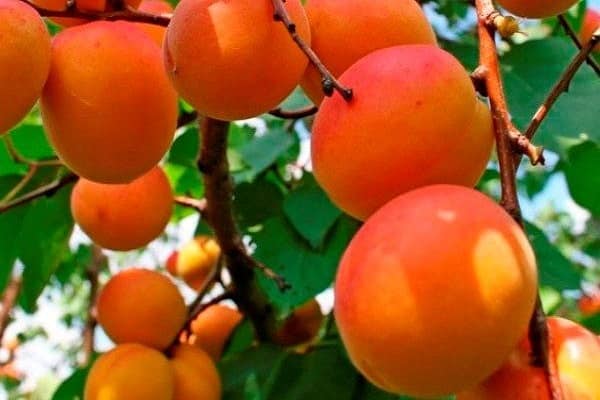

The variety Russian was obtained by selection by specialists from the research institutes in the North Caucasus and adapted to the climate of middle latitudes. Although this apricot is not included in the State Register of Crops Recommended for Growing in the country, both summer residents and gardeners are happy to plant it.
Late-ripening varieties
In order to get delicious fruits all summer long, it is worth planting trees of different yields in the garden.Since the early and middle varieties have already been covered, now is the time to move on to the later varieties. These include the following varieties.
Favorite
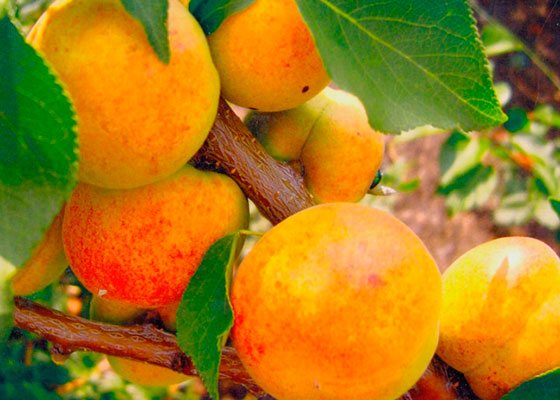

Average height - 3-4 meters. Ripening occurs towards the end of summer and lasts until mid-September. Here the fruits will be of medium size, not exceeding 30 g. Color - bright orange with a red tint on the side where the sun warmed the fruit. The pulp is quite firm, but sweet and tender. One tree per season brings a good harvest and is not afraid of frost. The favorite is excellent not only for fresh consumption, but also for preservation.
Honey
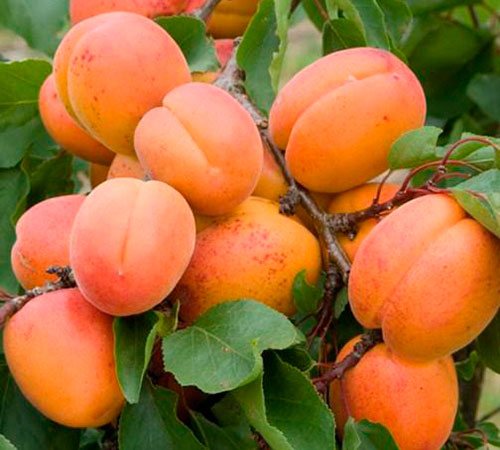

This type of adult tree has a very wide crown and a height of 4 meters. Therefore, when choosing a landing site, you need to take this moment into account. Despite its exquisite sweet taste, such an apricot can be considered small-caliber, since one fruit usually weighs 15-20 g. The color is light yellow with small red dots on the surface of the rind. The honey variety brings a bountiful harvest (as compensation for its small size) and is absolutely not afraid of frost.
If you competently approach the arrangement of your garden, then throughout the year you can pamper yourself with apricots: in the summer - fresh, and in the winter - canned.
Honey
The tree of this variety can reach a height of 4 m and has a voluminous and spreading crown. Small fruits grow on it. Their skin is yellow, with small red dots and slight pubescence. The pulp is of medium density, yellow in color, fibrous-granular and sweet in taste.
The Medovy variety without shelter can withstand a drop in temperature to –35 ° С, and in snowy winters - and all –40 ° С.
| Appointment | Harvest | Tree height (m) | Fruit weight (g) | Productivity (kg per tree) |
| 1st half August | 2-4 | 15 | 15-20 | |
Varieties for climates with severe frosts
If the site is located in a sufficiently cold region, then you need to plant trees that are not afraid of frost. Summer residents speak positively about the following varieties:
Manchurian
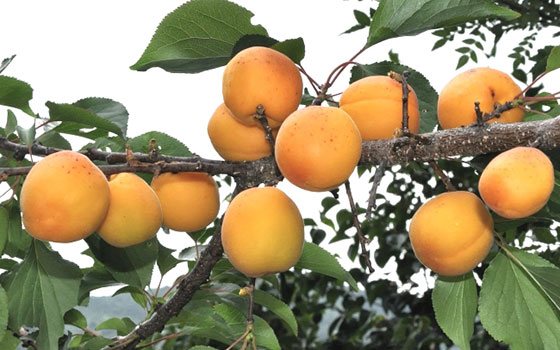

This species not only tolerates frost well, but also has a fairly long growth. They calmly go through winters with thirty-degree frost. These trees can also serve as a decorative design for the garden, as they are amazing during the flowering period. It should be noted right away that the fruits here are small - 15-20 g, but the height of one tree can vary from 10 to 15 meters. For lovers of sweet and sour, the Manchu variety is the most it. But it is recommended more for preservation than for fresh consumption.
Northern triumph
This variety has the most positive reviews about its frost resistance. There is no need for special care, since such an apricot copes well with diseases and pests. There is no need to choose a specific place for planting, because these trees are undersized (they grow approximately up to 2 meters), but with a spreading crown. The shape of the fruits is elliptical, weight is 40-60 g. By the middle of August, you can already taste the first fruits, which have an orange color with red tints.
Hardy
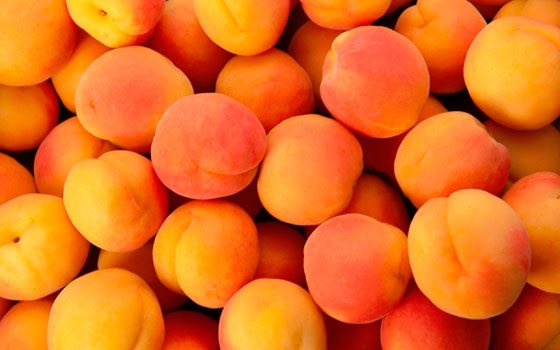

This variety is considered the best among the "walruses" in apricots. The main advantage of this type is the frost resistance not only of the tree itself, but also of flower buds, which is important for productivity. Requires a fairly large area, since mature trees have wide crowns.
The first harvest can be seen only in 5-6 years, with an average weight of one fruit in 40 g. Usually this process begins in mid-August, but one tree gives about 60 kg per season.
Lel
One of the sweetest apricots, although the fruits are small in size. An adult tree can reach 2.5-3 meters in height, but at the same time it has a fairly compact crown. The first crop is harvested in 3-4 years of planting. This variety is self-fertile. You can read more about this variety here.
Snegirek
Such a frost-resistant variety that it takes root even in the North. It is absolutely unpretentious in the soil.It is included in the category of low-growing trees, since its maximum height is 1.5 m. Moreover, each plant brings up to 10 kg of harvest per season. Has high rates of transportability. If the storage conditions are properly ensured, then fresh fruits can be enjoyed even in the middle of winter. But among the shortcomings, they distinguish low resistance to spotting and moniliosis.
Summing up, we can say that it is not so difficult for the Moscow region to choose apricots for planting. The main thing is to carefully consider all the features of the varieties and provide them with proper care.
How to choose the best apricot seedlings when buying
Experienced gardeners recommend purchasing seedlings only in nurseries, which will be a guarantee of obtaining high-quality planting material. When buying a plant, be sure to check for diaper rash and rotten roots. If, with a slight tension, the roots peel off from the trunk, then the seedling is spoiled and you should not take it. The planting material should be one- or two-year, 1 m high, and the rhizome - up to 40 cm. It is necessary to make sure that there is a grafting, which will guarantee the authenticity of the variety.
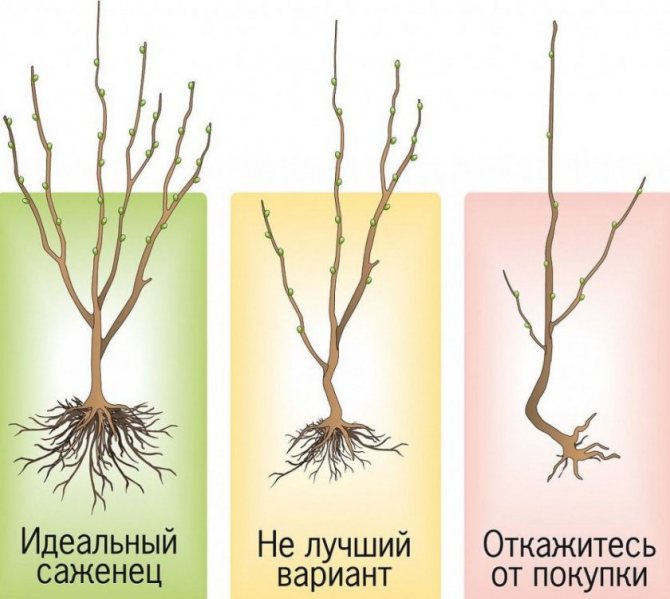

Features of growing apricots in the Moscow region
Apricot care in the Moscow region has its own nuances - this is due to the climate of the region. Therefore, we remember the following recommendations:
- when spring planting is carried out, a place is chosen for the seedling where it is maximally warm and a lot of sunlight;
- when planting several apricots, use a 6 by 4 square scheme, where the first number means the step of the row, and the second means the step in the row;
- the optimal parameters of the pit for the seedling are 70 x 70 x 70 cm;
- an apricot in a new place is watered every 2 weeks.
If the question of where it is better to plant the apricot on the site has been resolved and the tree has taken root, then from the second year they begin to spray it with pest control and fertilize it. But each variety requires its own protection and feeding. Therefore, in order to avoid problems, even at the time of purchase, the seller should be interested in this issue. And then, in a couple of years, there will be a plate with delicious and delicate fruits on the table.
"Hardy"
This variety got its name for its resistance to frost and cold weather, although the tree is quite sensitive to spring temperature changes. The tree is strong and large and grows quickly enough. The crown is dense and branched.
This variety is a representative of the selection of the Nikitinsky garden. The fruits of this variety ripen late - in early - mid-August, this apricot variety is large-fruited, and the fruits can reach 35-45 g.
The fruits are flat-round, colored in a beautiful, rich golden-orange color with a pronounced blush. The medium-sized stone is easily separated from the pulp, which has a wonderful delicate aroma and rich taste.
The first fruits will appear only 5-6 years after planting the tree. This is a fairly high-yielding variety of apricot, and during the season from one tree you can collect from 60 to 80 kg of fresh fruits, which are great for eating both raw and ready-made.
Apricot "Aquarius" is the brainchild of the Main Botanical Garden of Russia, bred by A.L. Kramarenko. "Aquarius" - this is a seedling of an apricot variety "Lel". An adult tree with a large crown can reach 6 meters in adulthood.
The tree blooms with very bright white flowers, although the flowers themselves are quite small. On the fruit of the "Aquarius" variety, a distinct seam is visible, and the average weight ranges from 27 to 32 g. The fruit itself is colored yellow with a muted blush.
The pulp of the fruit is of medium density and has a very harmonious sweet and sour taste. The small stone is easily separated from the pulp. Apricot "Aquarius" is a fairly disease-resistant tree, but it can be affected by scab, a disease caused by a fungus of the Venturia family.
Apricot "Guiani" represented by a rather tall and powerful tree with a densely branched spreading crown. This variety is frost-resistant and unpretentious to care for. The yield of this variety is at a fairly high level. "Gviani" is a self-fertile variety. This tree is quite disease resistant.
Gwiani bears fruit in its fourth year of growth. The fruits are rather small in size and grow no more than 20-25 g. The fruits are bright yellow, and this apricot is red-cheeked. The fruits are distinguished by a glossy shine and a pointed tip.
The core has a sweet taste, and the pulp itself is sweet and sour and very juicy, and the overall taste is very harmonious. The stone is medium in size and separates well from the total mass of the fruit.
The fruits of this variety ripen rather late - in mid - late August.
This variety attracts both breeders and amateur gardeners also because it is well stored and well transported, and it is also extremely unpretentious to growing conditions.
"Countess" - medium-ripening apricot variety. Winter hardiness and cold resistance of this variety is much lower than that of other varieties, and this plant is most often exposed to
clotterosporium disease.
The fruits of the "Countess" grow up to 20-30 g. If the weather is warm and dry, the fruits will be healthy, but during periods of cool and rainy weather, the fruit can be covered with black dots and even a solid crust of clotterosporium. The first fruits can be harvested 3-4 years after planting.
Apricot "Zeus" represented by a not very tall tree, which at maturity does not exceed three meters.
This species is characterized by an average resistance to diseases.
This variety bears fruit quite well: 20-30 kg of fruits are harvested from one mature tree, and, importantly, Zeus has regular fruiting.
The fruits of this variety are not too large - 20 g. The skin of the fruit is thin and painted in a bright yellow color, decorated with a not very bright blurry blush on top. The fruits can be harvested from mid-August.
After planting, the first fruits can be harvested in the third or fourth year.
"Lel" is a variety that begins to bear fruit in the fourth year after planting. Bred in the State Botanical Garden in 1986. This variety is represented by a tree of medium height (up to 3 m), the branches of which are collected in a small neat crown. The growth is very moderate.
In autumn, the apricot leaves "Lel" acquire a reddish color. White flowers grow up to 3 cm in diameter. "Lel" bears fruit a week or two later than "Alyosha" and "Iceberg".
Fruits with a glossy sheen, their weight is 20 g. The fruit is not pubescent, round, with flattened sides. The color of the fruit is orange and no blush.
The fruits of this variety can be eaten both raw and ready-made, very often this particular variety is used for making dried apricots.
"Northern Triumph"
Variety "Triumph North" - the result of crossing the varieties "Early Severny" and "Krasnoshchekiy". Initially, this variety was created for cultivation in the central zone, and this fact makes it difficult for this variety to winter in the Moscow region, although, in principle, it has already been adapted, and this variety survives the winter quite well.
This variety is represented by a vigorous tree with a very large, dense and spreading crown, so if you are just planning to plant this variety in your garden, you need to plan it so that the Northern Triumph does not overshadow the rest of the plants.
The fruits of this variety are large, reaching 55 g. The fruits are yellow-orange in color, and from the side, which is usually in the shade, a small green is visible, the skin is pubescent.
The orange pulp has a pleasant taste that literally melts in your mouth. The stone is small and easily separated from the pulp.
According to some parameters, "Northern Triumph" is weaker than the varieties described above, but this type is no less popular among gardeners in the Moscow region.
This variety, unlike the others, was bred much later, in 2000. Representatives of this variety are medium-sized trees that reach a maximum height of 3-4 meters.
It blooms in white, the flowers themselves are medium in size: 3-3.2 cm in diameter. The shoots of this tree are annual and highly branched. This variety bears fruit at the same time as "Monastyrsky".
The fruits of this variety are rather large, reaching 30 g, with an uneven, slightly pubescent skin, colored orange with a bright large blush spot. The bright orange pulp has a very rich taste and was awarded 5 points on the tasting scale.
The stone of this fruit is rather small - 8% of the total mass, and it separates well from the pulp. The fruits can be eaten both raw and cooked. This variety keeps well enough and does not need special care during transportation.
This variety was bred in 1986 in the State Botanical Garden. These are trees of medium height, which reach 3-4 meters in adulthood.
The stone makes up 10% of the total mass of the fruit and, due to its strong juiciness, is not always cleanly separated from the pulp. Fruits can be harvested 3-4 years after vaccination. The yield is not very large, but it is marked by regularity.
Transportation and storage of fruits does not require special conditions. The fruits can be eaten both raw and cooked, even in the preparation of jam, they will retain their taste and aroma.
The apricot variety "Edelweiss" was bred in 1975. This is a medium-sized tree with a spherical crown.
The fruits ripen in mid - late August. Fruits are round, with slightly flattened sides.
The skin is rather thin, painted in a bright light orange color and decorated with an orange blush. The pulp with a rich sweet and sour taste and a pronounced aroma.
This variety gives quite a lot of fruits: one adult tree brings up to 30 kg of harvest. The variety is winter hardy and tolerates any risk of disease well.
"Edelweiss" is distinguished by good drought resistance. All these factors have contributed to the fact that this variety is considered universal and has been repeatedly awarded for its positive properties.
As you can see, there are many varieties that can easily adapt to your area near Moscow and will make your summer even sweeter. The main thing is to choose a variety that suits you "according to taste and color" and give it good care, and the tree will serve for many years to the delight of you and your household.
"Monastyrsky"
The Monastyrsky variety was bred in 1996 in the State Botanical Garden. This variety is represented by a vigorous tree with a spreading crown.
It blooms with not very large white flowers - up to 3 cm in diameter. All types of shoots bear fruit. Most often, the weight of the fruit is no more than 30 g, and the yield of the variety is quite high and regular.
Recommended reading: Huter Chainsaws Very soon, the Huter concern will celebrate its 50th anniversary. During this time, the company has evolved from a small supplier
The pulp of the fruit has a rich yellow color and a little mealy, the taste is sweet and sour, the aroma is not very pronounced. The stone is flat and makes up 12% of the total mass of the fruit, it is separated with little effort.
Read also: How to prepare apricots for the winter - Blanks for the winter, Recipes, tips, descriptions, reviews
Variety "Russian" has the ability to produce high yields and a fairly strong winter hardiness and cold resistance. "Russian" is a large tree with a medium-sized crown. The tree itself is not tall, and this simplifies the task of harvesting.
The fruits of this variety are round in shape with "squeezed" sides, painted in a bright yellow color with a slight blush. The bright yellow pulp is hidden under the slightly pubescent surface and has a very delicate, but well-defined aroma.

